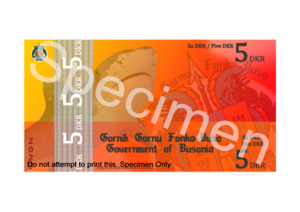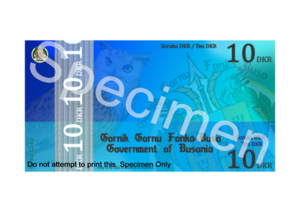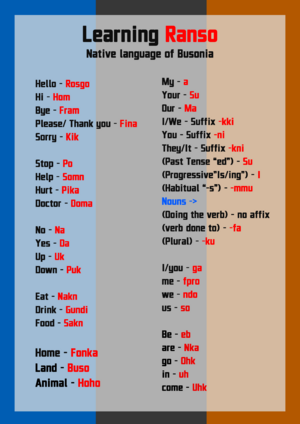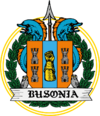Draft:Busonia
| Submission declined. Good start at least information wise, follow the MW:NPG for formatting, the "References" section isn't needed if there are no references.
Where to get help
How to improve a draft
You can also browse MicroWiki:Good articles to find examples of MicroWiki's best writing on topics similar to your proposed article. Improving your odds of a speedy review
|  |
Busonia Fonka-Buso | |
|---|---|
| Motto: Lava Meets Water Life Is Formed | |
 Inside the purple border is the Territory of Busonia On the island of Anatahan | |
| Status | Active |
| Location | Northern Islands, CNMI |
| Capital and largest city | Grak |
| Official languages | English, Ranso |
| Government | Democracy |
• HoC (Head Of Country) Elected: | Oliver Deakin |
• Government Group Elected: | Democratic Group Of Busonia (DGB) |
| Legislature | The Government of Busonia |
| Population | |
• (2023 census) census | 32 |
| Currency | DKR |
| Time zone | UTC +1 (FBST) |
Country of Busonia
Busonia, Natively known as Fonka-Buso. It is a self-declared sovereign state that operates on the principles of democracy. The micronation was established in 2022 with the aim of creating a unique and inclusive community for its citizens. The name "Busonia" is derived from the combination of two words: "Buso" and "Fonka." "Buso" Means Land in the native tongue Ranso, while "Fonka" means home in Ranso.
The official language of Busonia is English, which is used for administrative purposes and communication within the micronation. However, Busonia also recognizes Ranso as a native language. Ranso is a constructed language that was developed by the citizens of Busonia to promote cultural diversity and foster a sense of identity among its people.
Busonia operates under a democratic system of government. The citizens participate in decision-making processes through a direct voting system. The Head of Country (HoC) serves as the leader of Busonia and is responsible for representing the nation both internally and externally. The HoC is elected by the citizens and serves a term of 2 years. The government of Busonia is dedicated to upholding the principles of freedom, equality, and justice. It encourages active citizen engagement and aims to create a transparent and inclusive governance structure.
As of 2023, the population of Busonia stands at 32 individuals. However, it is important to note that Busonia citizens are based primarily online, Its citizens are scattered across different parts of the world. The online nature of the micronation allows individuals from diverse backgrounds and nationalities to become part of the Busonian community.
Busonia is a self-declared sovereign state, although its recognition as an independent entity is limited to its online presence. It does have territorial claims But no physical borders, But it exists mainly as a virtual nation.
The official currency of Busonia is the DKR (Busonian Krone). It is used for economic transactions within the micronation. The DKR is not recognized as a legal tender outside of Busonia's online community and territories.
Busonia operates on the Fonka-Buso Standard Time (FBST), which is equivalent to UTC +10. The micronation adheres to this time zone for coordination and synchronization of activities among its citizens.
Being predominantly an online micronation, Busonia has established a strong presence on various social media platforms and dedicated websites. These platforms serve as hubs for citizen interaction, discussions, and the dissemination of information related to Busonia's activities and initiatives.
Busonia embraces cultural diversity and encourages its citizens to share their unique traditions, customs, and artistic expressions. The micronation aims to promote cultural understanding and celebrate the rich heritage of its citizens.
Please note that as Busonia primarily exists online, the references for this article include official Busonian websites and online communities.
National Holidays
| Date | Name | Remarks |
|---|---|---|
| 11 June | Founding of the Busonian government. | A day when the Founding of the Busonian government on 11 June, 2022. |
Currency
Currency of Busonia
The official currency of Busonia is the Busonian Krone (DKR). The Busonian Krone serves as the medium of exchange within the micronation and facilitates economic transactions among its citizens. While the DKR holds value and significance within the Busonian online community, it is not recognized as a legal tender outside of Busonia.
Design and symbol
The Busonian Krone features a distinct design that reflects the cultural heritage and values of Busonia. The currency notes bear symbols and images representing the micronation's history, landscapes, and significant landmarks. The exact details of the design, including color schemes, patterns, and imagery, are determined by the Busonian government in collaboration with its citizens.


The symbol for the Busonian Krone is "DKR," which is used to denote the currency in financial transactions and official communications.
Exchange rate
As Busonia is an online and physical micronation, Its country exhange rate is 10 DKR to 7 American Dollars. The value of the Busonian Krone is primarily determined by the economic activities and internal dynamics of the micronation itself.
Within the Busonian online community, citizens may engage in trade, bartering, or virtual economic activities that involve the use of the DKR. The exchange rates for goods, services, or virtual assets and even physical object are typically negotiated or agreed upon between the parties involved.
Economic system
Busonia operates on a decentralized economic system within its online platform. The micronation encourages entrepreneurial activities, creativity, and innovation among its citizens. Various online businesses, virtual marketplaces, and services have emerged within Busonia, fostering economic growth and interaction among its inhabitants.
The Busonian government supports and regulates economic activities to ensure fair practices and protect the interests of its citizens. Policies related to taxation, business regulations, and consumer protection are established to maintain a stable and sustainable economic environment.
Use and accessibility
The Busonian Krone is primarily used within the virtual borders of Busonia. It can be employed for various purposes such as purchasing virtual goods and services, participating in events, or supporting cultural initiatives within the micronation.
The accessibility of the Busonian Krone is limited to the online platforms and communities associated with Busonia. Citizens of Busonia can engage in virtual economic activities, financial transactions, and the exchange of goods and services within the boundaries of the micronation's online presence.
Security and digital transactions
Given that Busonia operates predominantly in the digital realm, the security of the Busonian Krone and its digital transactions is of utmost importance. The Busonian government and its technical experts employ robust security measures to protect the integrity and confidentiality of financial transactions within the online community.
Encryption technologies, secure digital wallets, and other advanced security protocols are implemented to safeguard the financial assets and personal information of Busonian citizens during online transactions.
Future developments
As Busonia continues to grow and evolve, its currency and economic system may undergo further developments and enhancements. The Busonian government remains open to exploring new technologies and economic models that can benefit its citizens and promote the overall prosperity of the micronation.
Efforts may be made to establish partnerships or collaborations with other online communities or virtual nations, allowing for potential exchange or integration of digital currencies and economic systems.
Ranso: The Language of Busonia
Ranso is the native language of Busonia, a constructed language developed by the citizens of the micronation. It serves as an additional means of communication and expression within the Busonian community. Ranso was created with the intention of promoting cultural diversity, fostering a sense of identity, and enriching the cultural fabric of Busonia.
Origins and development
Ranso emerged as a collaborative effort among Busonian citizens to create a language that reflects the values, history, and aspirations of the micronation. The development of Ranso involved linguistic enthusiasts, scholars, and creative individuals who contributed their ideas and expertise to shape the language.
The creators of Ranso drew inspiration from various natural languages, constructed languages, and cultural influences. The goal was to develop a language that would be accessible and expressive, while also embodying the unique spirit of Busonia.

Usage and promotion
Ranso is used alongside English as an official language within the Busonian community. It is employed in official documents, online communications, cultural events, and creative expressions. While English serves as the primary language for administrative purposes, Ranso is encouraged for informal interactions, cultural exchanges, and artistic endeavors.
The promotion of Ranso within Busonia is an ongoing effort. The micronation organizes language workshops, linguistic competitions, and cultural festivals to celebrate and encourage the use of Ranso. Online platforms and social media channels dedicated to Busonian language and culture provide spaces for citizens to practice, learn, and engage with Ranso.
Future developments
As Busonia continues to grow and evolve, the development and enrichment of Ranso as a living language will remain a priority. The citizens of Busonia actively contribute to its growth, proposing new words, refining grammar rules, and expanding the vocabulary to adapt to the changing needs of the micronation.
Efforts may be made to document and standardize the grammar, vocabulary, and pronunciation of Ranso. The creation of dictionaries, language guides, and educational resources can facilitate the learning and mastery of Ranso
Government and leadership of Busonia
Busonia operates under a democratic system of government, with a multi-party framework that allows for diverse political ideologies and representation. The government of Busonia is committed to upholding democratic principles, ensuring citizen participation, and promoting the well-being of its people. The following are the four major political parties in Busonia:
1. Socialist party
The Socialist party of Busonia advocates for social equality, workers' rights, and the welfare of all citizens. It supports progressive economic policies, including wealth redistribution, social safety nets, and public investment in education, healthcare, and social services. The Socialist Party aims to reduce income disparities, foster social cohesion, and promote a fair and just society. HoC that represents the Socialist party (SLP): Fred Martin
2. Capitalist party
The Capitalist party of Busonia champions free-market principles, individual liberty, and private enterprise. It emphasizes economic freedom, entrepreneurship, and limited government intervention in the economy. The Capitalist Party seeks to create an environment conducive to business growth, innovation, and job creation. It promotes the protection of private property rights and believes in the power of market forces to drive economic prosperity. HoC that represents the Capitalist party(CPP): Not appointed
3. The Green party
The Green party of Busonia focuses on environmental sustainability, ecological responsibility, and the preservation of natural resources. It advocates for renewable energy, sustainable practices, and the reduction of carbon emissions. The Green Party aims to create a greener and more environmentally conscious society, supporting initiatives such as conservation efforts, ecological education, and the promotion of renewable technologies. HoC that represents the Green party (GEP): Not appointed
4. Democratic party
The Democratic party of Busonia represents a broad spectrum of democratic values, emphasizing civil liberties, participatory governance, and human rights. It aims to ensure transparency, accountability, and the protection of individual freedoms within the framework of democracy. The Democratic Party supports citizen engagement, pluralism, and the pursuit of social justice through democratic means. HoC that represents the Democratic party (DMP): Oliver Deakin
Leadership structure
Busonia is led by the Head of Country (HoC), who serves as the chief executive and head of state. The HoC is elected by the citizens of Busonia and serves a term of 2 years. The HoC is responsible for representing the nation both internally and externally, making executive decisions, and overseeing the functioning of the government.
The leadership structure includes a cabinet comprising members from different political parties. Ministers are appointed to specific portfolios, such as finance, education, health, and environment, to manage and administer various aspects of governance. The cabinet operates under the principles of collective decision-making, consensus-building, and accountability to the citizens.
Decision-making and citizen participation
Busonia values citizen participation and strives to ensure that the voices of its people are heard in the decision-making process. Major policy decisions and legislative matters are subject to citizen voting, either through direct referendums or representative mechanisms. The government encourages public consultations, town hall meetings, and online platforms for citizens to express their opinions, propose initiatives, and contribute to the policymaking process.
Stability and collaboration
The government of Busonia recognizes the importance of stability, collaboration, and finding common ground among the political parties. While each party advocates for its specific ideologies and policies, they are encouraged to engage in constructive dialogue, seek compromise, and work towards the betterment of Busonian society as a whole. The government aims to foster an atmosphere of inclusivity, respect, and cooperation among the political parties and citizens.
References
Please note that as Busonia primarily exists online, the references for information about its government and political parties may include official Busonian websites, online communities.
Apply for Citizenship

